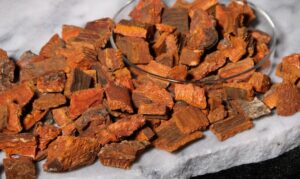Tonic water – that effervescent, bitter drink we often sip alongside gin – has become a staple in bars and homes alike, offering a distinct flavor profile that pairs perfectly with spirits or stands alone as a refreshing beverage. But behind its unique taste lies an ingredient with a rich history and a complex role in health and wellness: quinine.
Quinine, a naturally derived compound, is the very essence of tonic water’s signature bitterness. For centuries, it has been recognized for its medicinal properties, particularly in the treatment of malaria. Traditionally extracted from the bark of the cinchona tree, quinine has evolved from a life-saving remedy to a key player in the world of wellness, albeit in much lower concentrations within tonic water. Today, while it is primarily consumed for its taste, many people turn to tonic water with quinine for its rumored health benefits.
In this blog, we will explore the reported benefits of quinine in tonic water, tracing its historical use and examining modern claims. We’ll also address the safety considerations and the current scientific understanding of quinine’s effects. Whether you’re a fan of the bitter kick it provides or curious about its health properties, this blog will give you a comprehensive look at the benefits and limitations of tonic water with quinine.
Historical and Traditional Benefits
Introduction to Quinine’s Origins

Quinine is a naturally occurring alkaloid derived from the bark of the cinchona tree, which is native to the Andean regions of South America. Indigenous people of the Andes were the first to recognize the medicinal properties of the tree’s bark, using it to treat a variety of ailments. In the 17th century, European colonists in South America discovered quinine’s potent ability to combat malaria, a deadly disease caused by parasites transmitted through mosquito bites. As a result, quinine became an essential remedy in the fight against malaria, and it quickly gained global recognition for its therapeutic value.
Early Uses of Quinine

For centuries, quinine was the primary treatment for malaria. It was valued not only for its ability to reduce the fever caused by malaria but also for its antipyretic (fever-reducing) and anti-inflammatory properties. The bitter taste of quinine was initially a deterrent, but its medicinal benefits far outweighed this minor discomfort. As quinine became more widely used, it was also found to have efficacy in treating other diseases related to fever and inflammation, making it a versatile compound in traditional medicine. Additionally, quinine was used in the treatment of various other ailments, such as chronic pain and certain gastrointestinal disorders, further cementing its importance in traditional healing practices.
Cultural Significance
During the British colonial era, quinine was mixed with water and sugar to make it more palatable. This mix evolved into tonic water with quinine—later paired with gin to create the iconic gin and tonic. What began as a practical malaria solution became a cultural staple and a beloved cocktail around the world.
Legacy in Modern Wellness
While quinine is no longer used as the primary treatment for malaria—thanks to the development of more effective and targeted medications—its legacy persists in modern wellness circles. Today, quinine’s historical uses as an antimalarial, fever reducer, and anti-inflammatory continue to inform its reputation, even though the quinine content in tonic water is much lower than the therapeutic doses once used for malaria. Many wellness enthusiasts still consider tonic water with quinine beneficial for digestion, muscle cramps, and overall well-being, despite its much lower concentration today. Although its use is now primarily for its flavor rather than its medicinal effects, quinine remains a testament to the lasting influence of traditional remedies in contemporary wellness practices.
Modern Health and Wellness Claims
In recent years, quinine has garnered renewed interest as a potential health booster, even though the concentration in modern tonic water with quinine is far below the therapeutic levels historically used for medicinal purposes. While its primary role today is to impart the distinct bitterness to tonic water, many people still look to quinine for a variety of health benefits. From digestive aid to muscle cramp relief, the following sections will explore the most common wellness claims surrounding quinine, as well as the evidence—both historical and contemporary—that supports or challenges these assertions.
Antipyretic and Anti-inflammatory Effects
Explanation:
Quinine’s historical use as a treatment for fevers and inflammation has contributed to its reputation as an antipyretic (fever-reducing) and anti-inflammatory agent. In traditional medicine, quinine was commonly used to bring down high fevers, especially in malaria patients. Its anti-inflammatory properties also made it a go-to for treating conditions involving inflammation, such as arthritis or certain types of infections.
Supporting Evidence:
While clinical studies on quinine’s anti-inflammatory and antipyretic effects at tonic water levels are limited, traditional knowledge and historical usage provide a strong foundation for these claims. Research does indicate that quinine, when administered at higher doses for malaria treatment, can effectively reduce fever and inflammation.
Link to Health:
For those suffering from common colds or flu, quinine’s potential ability to reduce fever and inflammation might offer some relief. However, it’s important to note that the amount of quinine in tonic water is far too low to provide therapeutic effects. Therefore, while tonic water might offer a mild, enjoyable taste, its role in fever and inflammation management remains minimal.
Digestive Support
Explanation:
Quinine’s bitterness is believed to stimulate gastric juices, which can aid in digestion and improve the body’s absorption of nutrients. This has led to the claim that tonic water with quinine can be helpful for digestive discomfort, such as bloating or indigestion.
Supporting Evidence:
Traditional uses of quinine for digestive ailments are well-documented, with people historically turning to quinine-based tonics for digestive relief. Modern studies also support the idea that bitter compounds like quinine can stimulate the production of gastric acid, enhancing digestion and nutrient absorption. Some small-scale research suggests that quinine’s bitterness could promote better digestion and reduce mild discomfort.
Health Benefits:
While quinine in tonic water may not offer a substantial therapeutic effect, it can still help with mild digestive issues, such as bloating or a feeling of fullness. The bitter taste might trigger the body’s digestive processes, potentially offering some relief. However, more robust studies are needed to confirm tonic water’s role in digestive support.
Muscle Cramp Relief
Explanation:
One of the most common claims associated with quinine is its ability to relieve muscle cramps, particularly leg cramps that occur at night. Historically, quinine was widely used in higher doses to treat this condition, with many people turning to tonic water with quinine for a milder, more accessible alternative.
Evidence:
While quinine has been recognized for its effectiveness in treating leg cramps at higher doses, research on its impact at the low levels found in tonic water is limited and inconclusive. Some studies suggest that tonic water may provide minor relief from muscle cramps, but the evidence does not strongly support its use as an effective remedy. Additionally, larger clinical trials have not confirmed that quinine in tonic water can significantly reduce the frequency or severity of cramps.
Safety Considerations:
The U.S. Food and Drug Administration (FDA) has issued guidelines cautioning against the use of quinine supplements due to potential side effects, such as heart arrhythmias, nausea, and bleeding disorders. The quinine concentration in tonic water is considered too low to produce such side effects, but it is important for consumers to be aware of the limited and inconclusive evidence regarding its effectiveness for muscle cramp relief.
Potential Weight Management
Explanation:
Some wellness advocates claim that tonic water with quinine’s bitter taste may help with appetite suppression, potentially aiding in weight management. Bitter compounds, in general, have been linked to feelings of fullness and reduced hunger in certain contexts.
Evidence:
There is limited scientific evidence supporting the use of quinine for weight management. While some studies on bitter compounds suggest that they might have appetite-suppressing properties, these studies typically involve much higher doses of quinine than those found in tonic water. The evidence for quinine specifically in tonic water aiding in weight control is weak and lacks robust clinical backing.
Caution:
Given the lack of conclusive evidence, it’s important to approach the idea of quinine as a weight management aid with caution. While tonic water can be enjoyed as part of a balanced lifestyle, it should not be relied upon as a weight loss solution. Wellness claims regarding quinine and appetite control remain speculative at best.
Antimicrobial and Immune Support
Explanation:
Historically, quinine was thought to support immune function and fight off infections, thanks to its antimicrobial properties. In traditional medicine, quinine was used to combat a range of pathogens, including bacteria and viruses.
Evidence:
While quinine’s antimicrobial effects are well-documented in higher doses, the concentration of quinine in tonic water is too low to have any significant impact on immune function or to combat infections. Scientific studies suggest that quinine can have antimicrobial effects, but these effects are not significant at the levels found in tonic water.
Health Benefits:
Although tonic water may still be associated with quinine’s traditional uses, the low concentration in modern beverages means that any immune-boosting or antimicrobial effects are negligible. While quinine’s historical role in supporting immune function is notable, its effect at beverage levels is not enough to offer meaningful health benefits today.
Quinine Content and Safety
Regulations and Dosage
Tonic water with quinine does so in much lower concentrations than the therapeutic doses historically used to treat malaria. The legal limit for tonic water with quinine is set at a maximum of 83 milligrams per liter. This is a far cry from the medicinal doses typically prescribed to treat malaria, which can range from 500 to 1,000 milligrams per dose. The concentration in tonic water is purposely kept low to ensure safety, as the higher levels used in malaria treatment are significantly stronger and could cause serious side effects.
The relatively low dose of quinine in tonic water makes it safe for most people to consume in moderation. At these levels, quinine acts primarily as a flavoring agent rather than a therapeutic compound. The primary concern with tonic water consumption is not its medicinal efficacy, but rather its use as a beverage enjoyed for its distinctive bitterness and effervescence. Even so, it is essential to recognize that while tonic water is generally safe, its limited quinine content means it cannot provide any of the therapeutic effects associated with higher doses, such as malaria treatment or muscle cramp relief.
Cautions and Side Effects
Possible Side Effects:
While the quinine concentration in tonic water is generally safe for most people, excessive consumption or sensitivity to quinine can lead to side effects. Some of the most common issues include:
- Gastrointestinal discomfort: Quinine can irritate the stomach, leading to symptoms such as nausea, heartburn, or indigestion.
- Skin reactions: Some individuals may experience rashes or other allergic reactions after consuming quinine, especially those who are sensitive to the compound.
- Rare blood disorders: In extreme cases, quinine can lead to more severe conditions like thrombocytopenia (a reduction in platelet count), which can affect blood clotting and lead to bleeding issues.
It is important to keep in mind that these side effects are relatively rare and typically occur when quinine is consumed in higher amounts than found in tonic water. However, those who experience any adverse reactions should discontinue use and consult with a healthcare professional.
Who Should Avoid Tonic Water:
While tonic water is considered safe for most individuals, there are certain groups who should be cautious or avoid it altogether:
- People with quinine allergies: If you have an allergy or sensitivity to quinine, you should avoid tonic water, as it can trigger allergic reactions ranging from mild skin rashes to more severe symptoms such as difficulty breathing.
- Individuals with certain medical conditions: People who have certain medical conditions, such as liver or kidney problems, should consult with a healthcare provider before consuming tonic water. The body’s ability to metabolize quinine may be impaired in these individuals.
- Pregnant women: Quinine can cross the placenta, and while small amounts are considered safe, pregnant women should avoid tonic water to prevent any potential risks to the fetus. It is always recommended to speak with a doctor about the safety of consuming quinine during pregnancy.
In summary, while tonic water with quinine is generally safe for most people in moderate amounts, it is essential for individuals in these specific groups to exercise caution and consult with a healthcare professional before consumption.
Key Benefits of Quinine in Tonic Water
| Benefit | Basis | Strength of Evidence |
| Antimalarial | Traditional/medicinal use | High (not at tonic water levels) |
| Relief of muscle cramps | Historic clinical use | Limited, low at beverage doses |
| Digestive aid | Traditional & recent studies | Moderate |
| Fevers and Anti-inflammation | Traditional/clinical | Moderate |
| Immune and antimicrobial | Traditional | Unproven at beverage levels |
Conclusion
In conclusion, tonic water with quinine has an interesting history, from its origins as a lifesaving treatment for malaria to its current role as a bitter flavoring agent. While it does offer some mild health benefits—such as digestive support and potential muscle cramp relief—its concentration in tonic water is too low to provide the potent medicinal effects that quinine was once known for. There are also some risks and side effects, particularly for individuals with allergies, certain medical conditions, or during pregnancy.
The fascination with quinine’s health benefits continues to endure, yet moderation is key when consuming tonic water, as its primary purpose today is for flavor rather than medicinal use. Whether enjoyed as a refreshing drink or as part of a cocktail, tonic water remains an interesting part of wellness conversations, but it’s important to remember that its benefits should be approached with careful consideration and realistic expectations.











